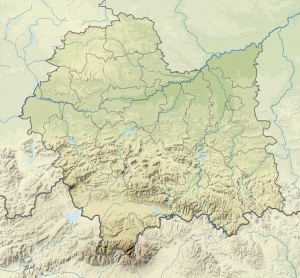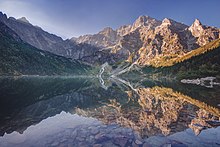Sea eye
|
Meerauge Polish Morskie Oko , Slovak Morské oko |
||
|---|---|---|

|
||
| View from the hiking trail to the Świstówka | ||
| Geographical location | High Tatras , Poland | |
| Drain | Rybi Potok | |
| Location close to the shore | Zakopane , Bukowina Tatrzańska | |
| Data | ||
| Coordinates | 49 ° 11 ′ 50 " N , 20 ° 4 ′ 12" E | |
|
|
||
| Altitude above sea level | 1395 m npm | |
| surface | 34.9 ha | |
| Maximum depth | 50.8 m | |
|
particularities |
Largest lake in the Tatra Mountains |
|





The sea eye ( pl. Morskie Oko , slk. Morské oko , German also: fish lake) in Poland is the largest and fourth deepest mountain lake in the High Tatras at the foot of the Mięguszowieckie Szczyty massif in the Dolina Rybiego Potoku valley . In 2014, The Wall Street Journal named the Meerauge one of the five most beautiful lakes in the world.
genesis
The Karsee is of Ice Age origin and represents the meltwater of the Ice Age glacier in the Białka Valley . The Karsee formed by the glacier is bordered in the north by a glacial moraine. The last glaciation took place during the Vistula glacial period about 115,000 to 11,600 years ago.
Dimensions
The sea eye lies at an altitude of 1395 m above sea level and, according to a survey by Józef Szaflarski in 1934, has an area of 34.9 ha, is 862 m long and 568 m wide, 50.8 m deep and has a volume of approx. 9,935,000 m³. According to a more recent survey by Adam Choiński , the maximum depth is 51.8 m. Its shore length is 2.45 km. It has an oval shape. The bottom falls at an angle of about 15 ° 20 ′. The water has a greenish hue of IV on the Forel-Ule scale . The visibility under water ranges from 11 meters (according to Józef Szaflarski) to 14 meters (according to Ludomir Sawicki ) depending on the measurement . There are clear thermoclines in the color, a so-called metal imnion . A measurement on August 2, 1937 showed that the upper water layer was 3 meters thick and had a temperature of 2.1 ° C. Up to a depth of 10 meters the temperature fell by 1 ° C / m and at depths of 10 to 20 meters by 0.25 ° C / m. The temperature in the depths below 20 meters was a constant 4 ° C down to the bottom.
Location and surroundings
The glacier lake lies at the foot of the highest mountain in Poland, the Rysy , which is also called the Meeraugspitze in German after the lake. The Polish-Slovak border runs over its summit.
Between the Rysy and the Meerauge there is another higher Karsee , the Czarny Staw pod Rysami , which drains into the Meerauge via a cascading brook.
Two year-round water-bearing streams flow into the lake, the Mnichowy Potok falls into the waterfall Dwoista Siklawa and the Czarnostawiański Potok falls into the waterfall Czarnostawiańska Siklawa . In addition, other watercourses flow into the lake, which also form waterfalls, but only carry water at times. The Rybi Potok flows out of the lake and forms the Rybie Stawki just below the lake: Małe Morskie Oko Żabie Oko and Małe Żabie Oko .
The valleys of the two glacial lakes are surrounded by the following mountain ranges:
- in the East:
- Siedem Granatów (Seven Grenades) ,
- Żabi Szczyt Niżni (Little Frog Point) (2098 m),
- Żabi Mnich (Rear Monk) (2146 m),
- Żabia Lalka (frog doll) (2095 m),
- Niżnie Rysy (Dénesspitze) (2430 m)
- in the south and southwest:
- Rysy (Meeraugspitze) (2503 m),
- Żabi Koń (Simonturm) (2291 m),
- Żabia Turnia Mięguszowiecka (Frog Lake Tower) (2336 m),
- Wołowy Grzbiet ( saddle of ox ),
- Kazalnica Mięguszowiecka (Mengsdorfer Kanzel) (2159 m),
- Mięguszowiecki Szczyt Czarny (Eastern Mengsdorf Peak) (2410 m),
- Mięguszowiecki Szczyt Pośredni (Middle Mengsdorf Peak) (2393 m),
- Mięguszowiecki Szczyt (Mengsdorfer Spitze) (2438 m),
- Cubryna (2376 m),
- Mnich (Mönch) (2070 m)
- in the West:
- Szpiglasowy Wierch (Liptauer Grenzberg) (2172 m),
- Miedziane (Kupferberg) (2233 m),
- Opalony Wierch (Brandkoppe) (2115 m)
Flora and fauna
With the exception of the couloirs, the banks are overgrown with mountain pines and Swiss stone pines . There are rare alpine plant species, including multi-part diamond fern , alpine turf rush , arm-flowered sedge , moss bells .
The valleys around the lake are a retreat for golden eagles, bears, chamois and marmots, among others.
Rainbow trout live in the lake. The bottom is filled with large boulders near the shore, gravel and sand follow at greater depths and organic remains of plants and animals follow from a depth of 40 meters.
Ice formation
The lake regularly freezes in November and thaws in May. In the record winter of 1950/1951, the lake did not freeze until January and thawed in March. The ice thickness has been measured regularly since 1971 and the measurements showed that the ice thickness is steadily decreasing. In the years 1971–1982 the lake was still frozen on an average of 171 days a year, the ice formed around November 20th, disappeared on May 9th and its average maximum thickness was 72 cm. In the years 1995–2007 the lake was frozen on an average of 157 days a year, the ice formed around December 5, disappeared on April 25 and its average maximum thickness was 56 cm.
etymology
The name Meerauge is a literal translation of the Polish name Morskie Oko and goes back to a legend according to which the lake has no bottom but is connected to the Baltic Sea or the Adriatic Sea. According to this legend, a pirate treasure was found in the lake from a ship that sank in the sea. This name was used in particular by the Carpathian Germans from the Spiš .
Another name for the lake is Fischsee ( pl. Rybie Oko ; literally: "Fish eye") and goes back to the fact that the lake is one of the few Tatra lakes that has fish. Hence the name of draining him of Bach Fischbach ( pl. Rybi Potok ), the smaller lakes north of the Sea eye located fish ponds ( pl. Rybie Stawki ) and the entire valley Fischbachtal ( pl. Dolina Rybiego Potoku ).
The oldest name of the lake is Weißsee ( pl. Biały Staw ) and dates back to 1650.
The numerous Karseen in the High Tatras are called Polish oka (German: "eyes", Sing. Oko ) or stawy (German "Weiher", Sing. Staw ), Slovak (and Czech) plesa (Sing. Pleso ); the lake is generally called jezioro in Polish , jazero in Slovak and jezero in Czech .
history
The lake was mentioned in a document for the first time in 1575. In 1637 the Polish King Władysław IV leased the Hala Morskie Oko alpine pasture on the lake to Władysław Nowobilski. The lake was acquired by Emanuel Homolacs in 1824 along with the goods around Zakopane . At the end of the 19th century, Władysław Zamoyski bought the goods from the Homolacs. The lake has been state-owned again since 1933 and has been part of the Tatra National Park since 1954 .
The lake was a popular destination for nature lovers as early as the early 19th century. In 1836 a first refuge was built on its banks. After this burned down in 1865, a new hut was built by the Tatra Society in 1874 . After this also burned down in 1898, it was rebuilt. In 1902, the Oswald-Balzer-Weg from Zakopane to the Meerauge was built. Car rallies were held on it in the 1930s.
In the 19th century, a violent legal controversy raged within the Habsburg Monarchy about whether the lake and its surroundings belonged to Galicia (today's southern Poland) or Upper Hungary (today's Slovakia), which the Polish legal scholar Oswald Balzer was able to decide before the Graz court for Galicia . The parties to the dispute were Christian Hohenlohe from Spiš and Władysław Zamoyski from Zakopane.
Culture
The sea-eye plays an important role in Polish culture. It is probably the most famous lake in Poland. Parks and gardens all over Poland are named after him.
Numerous poets have dedicated poems to him, such as Ludwik Solski , Maciej Bogusz Stęczyński , Wincenty Pol , Jadwiga Łuszczewska , Adam Asnyk , Kazimierz Przerwa-Tetmajer , Franciszek Henryk Nowicki and Jan Kasprowicz , and musicians songs, such as Zygmunt Noskowski .
Artists painted it since the early 19th century, including Walery Eljasz-Radzikowski , Leon Wyczółkowski, and Stanisław Gałek .
tourism
Mountain huts
The lake, which is one of the most popular destinations in the Tatras, can be reached either by horse-drawn carriage or sleigh via the Oswald-Balzer-Weg panoramic road , or about 9 km on foot. Once at the top, the Meeraughütte of the Polish Alpine Association ( PTTK ) stands on the moraine that closes off the lake to the north . The well-frequented hut is located at 1405 meters above sea level and is one of the oldest in the High Tatras area. The hut was named after Stanisław Staszic , who explored the lake in 1805. Next to the hut is the old Meeraughütte from 1890, which was used at times as a shed for horse-drawn sleighs. Both buildings are listed.
Hiking trails
The lake is u. a. to reach:
- ▬ from the parking lots on the Łysa Polana and Palenica Białczańska pastures via a red marked hiking trail over the Wodogrzmoty Mickiewicza waterfallalong the Oswald-Balzer-Weg panoramic road
- ▬ from Zakopane via Toporowa Cyrhla , Psia Trawka and Rówień Waksmundzka via a red marked hiking trail ( Lenin Trail )
- ▬ from the circular route around the mountain lake via a red hiking trail
- ▬ from the Dolina Pięciu Stawów Polskich valleyvia Świstówka Roztocka on a blue-marked hiking trail
- ▬ from the Szpiglasowa Przełęcz mountain passover the Ceprostrada on a hiking trail marked in yellow
- ▬ from the Mięguszowiecka Przełęcz pod Chłopkiem mountain passover the Mięguszowiecka Kazalnica on a green hiking trail
- ▬ from the Wrota Chałubińskiego mountain passover the Dolina za Mnichem on a yellow marked hiking trail
- ▬ from the summit Rysy over the mountain lake Czarny Staw pod Rysami on a red marked hiking trail
Web links
Individual evidence
- ^ Ruth Styles: Great Lakes Around the World. WSJ, accessed July 25, 2014 .
- ^ Józef Nyka, Dolina Rybiego Potoku (Morskiego Oka). Monografia krajoznawcza, Warszawa |, Sport i Turystyka, 1956
- ↑ Joanna Pociask-Karteczka, Cieplej w Tatrach ?, Tatry , 2009, No. 4 (30), 36
- ↑ Measurement on googlemaps
supporting documents
- Zofia Radwańska-Paryska, Witold Henryk Paryski: Wielka encyklopedia tatrzańska. Wyd. Górskie, Poronin 2004, ISBN 83-7104-009-1 .
- Tatry Wysokie słowackie i polskie. Mapa turystyczna 1: 25,000, Polkart, Warszawa 2005/06, ISBN 83-87873-26-8 .
panorama






